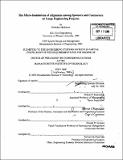The micro-foundations of alignment among sponsors and contractors on large engineering projects
Author(s)
McKenna, Nicholas A. (Nicholas Alan)
DownloadFull printable version (13.49Mb)
Other Contributors
Massachusetts Institute of Technology. Engineering Systems Division.
Advisor
Nelson P. Repenning.
Terms of use
Metadata
Show full item recordAbstract
Large engineering projects design, engineer and construct much of the world's energy, transportation and defense infrastructure. These large scale engineering endeavors are highly visible, have long lasting impacts and are of major economic significance. Yet despite their importance they frequently suffer from cost overruns and long delays and deliver systems with operational shortcomings. A contributing factor to the challenge of large projects is that the project enterprise is created by separate firms being brought together by the project sponsor, typically via formal contracts. Success requires multiple firms with hundreds (possibly thousands) of engineers working together to efficiently create complex product systems within an environment of high uncertainty. In an attempt to improve project outcomes, sponsors often endeavor to create "alignment" between themselves and their key contractors. In practice, alignment has proved difficult to create and to sustain. This research explores the policies and actions taken by firms that give rise to alignment. The large engineering projects studied for this research were offshore oil and gas field developments. grounded theory method, supplemented by formal dynamic model building, was used to investigate the causal mechanisms that support, or inhibit, the generation of alignment. The research revealed that alignment is founded on the collective understanding of the project, incorporating the firm's separate interests, and inter-firm trust. Furthermore the two antecedents of alignment act together to form a self-enforcing alignment mechanism. Six factors (system architecture, organizational design, contract design, risk, metrics and incentives) were identified that establish the inter-firm interactions through which collective understanding and inter-firm trust are created. These findings are organized into a framework that guides policy selection with a view to enabling the generation, and sustainment, of alignment. (cont.) A grounded theory method, supplemented by formal dynamic model building, was used to investigate the causal mechanisms that support, or inhibit, the generation of alignment. The research revealed that alignment is founded on the collective understanding of the project, incorporating the firm's separate interests, and inter-firm trust. Furthermore the two antecedents of alignment act together to form a self-enforcing alignment mechanism. Six factors (system architecture, organizational design, contract design, risk, metrics and incentives) were identified that establish the inter-firm interactions through which collective understanding and inter-firm trust are created. These findings are organized into a framework that guides policy selection with a view to enabling the generation, and sustainment, of alignment.
Description
Thesis (Ph. D.)--Massachusetts Institute of Technology, Engineering Systems Division, 2006. Includes bibliographical references (p. 216-230).
Date issued
2006Department
Massachusetts Institute of Technology. Engineering Systems DivisionPublisher
Massachusetts Institute of Technology
Keywords
Engineering Systems Division.